NO Reproduction in Whole or in Part,
on ANY, and ALL of my Pages,
Including Text and Pictures,
May be made, without the express Written Permission
of
Web Editor, Doug Gent
© 2016
Want to add a link to my
pages?
see my
Copyright Information
Page
for the only Authorized Picture Link allowed.
All Pictures on all my web pages, are now Visibly Watermarked,
All my pages are now Right Click, copy and paste, disabled.
I ask everyone that enjoys free history sites,
to start policing these violations.
If we don't stop this, no one will donate pictures to me or anyone,
and we all loose.
If you see one of my pictures on facebook, etc.
tell them to remove it.
|
**
WARNING **
Old
Abandoned Underground Coal Mines can be Very Dangerous,
Due to Collapse, and Mine Gases (Noxious and Flammable).
Extreme Care should be taken around them, due to Falls, Sudden Ground
Collapse, and Bad Air,
and in NO Circumstances should People enter into ANY Mine Openings, or
Associated Caves.
The Material Contained on my Sites,
is NOT to Encourage Personal Investigation of these Mines,
But only as a Historical Record of these Long Abandoned Mines.
Please View these Mines from a Far, Safe and Legal Distance.
Always Observe Private Property Rights, and Obey ALL Warning Signs.
************************************************
|
Brand Name: Dominion
Mined by: Western Dominion Collieries Limited
aka: Taylorton Mine
Taylorton Saskatchewan


Maps showing the location of this big mine
Left map 1927, right one from the 1955 book

Dec 1933 Map
of the "Big 5" Coal Mines near Bienfait
Located at
4-2-6 W. 2nd
This mine was situated on a mine spur
off the Souris Branch of the CPR.,
about five miles from Bienfait

Deep Seam Shaft Type Mine
Shafts as deep as 90 feet down
were dug in the era
Located just NE of Taylorton Cemetery
The First Commercial Coal Mine in the District
started near this location, shortly after 1880
By George Pocock of Emerson MB.
& his brother, Sir Sydney Job Pocock, of London England
Sydney & George Pocock
Hugh McKay Sutherland
from Winnipeg
was the first to mine the coal
with a 70 ft tunnel.
The first mine in this area was
at Roche Percee in 1891
The Hassard Mine was its name, owned by
Hugh Hassard
Later to become the Souris Valley
Coal Co. mine,
with a 8ft coal seam
This mine was sold to the John Taylor
family of Winnipeg
and renamed Western Dominion
Collieries Ltd. in 1905.

June 24, 1907 Company letterhead
courtesy Rob Taylor, Great-Grandson of
Richard Ratcliffe Taylor
Snr
This was the location of Taylorton
First managed by Andrew Miller
then Sam Holley, then Ed Pierce Jr.
(See
Eastern Collieries of Bienfait Ltd
for Pierce Family info)
In 1918 at the start of the Lignite Utilization Board
trying to form the
Char Briquetting
Plant
it was a subsidiary of the Trustees Corporation Ltd.,
London, England
Mar 1919



April 7, 1928 Western Dominion
Collieries Ltd.
had their office in Winnipeg MB at #305
Winnipeg Trust & Loan Co. Building, Portage Ave.
Part of the big
Six, time of Sept 29,1931 riot
2nd largest Mine in 1931.
Mine Managers / Executives:
Mr. Caleb Cox Symons (1847-Apr 28, 1933)
was Manager of this mine
buried in Estevan City Cemetery

------------------------------------
Managed by Charles Campbell Morfit
He was an American, who had experience
in the Pennsylvania USA coalfields.
He was Manager in 1931 during the Strike-Riot,
and one of the real problem Managers,
bringing in a dozen farmer scabs to run the mine.
The Local RCMP Sgt, was quoted as saying
Morfit was to blame for the strike,
and he was using it as an excuse to cover up
the mistakes he made on investing in the Char Plant,
and with a strike, his superiors could accept financial loss
due to a strike, rather than him loosing his job.
From the Wylie Commission
C.C. Morfit, a partner in the firm of
"Stuart, (Stewart?) James, and Cooke" of New York,
the largest concern of consulting engineers and efficiency experts in the world.
Mr. Morfit came in April, 1930 to take charge of
Western Dominion Collieries mine and briquetting plant,
his firm having been retained by the British shareholders of the company.
This firm was heavily involved in Russian Coal Mines as well
Here we have this firm making deals and money from "Communists" in Russia
then with the other owners and managers in the district,
complaining of "Communist" influence in the mines here.
He was leader of the
South Saskatchewan Coal Operator's Association in 1931
in 1938 he was being asked to partake in a study of Lignite in Greece for the
Germans.
in 1916 he was Superintendent of the J. B. B. Coal Company
at Twin Branch, West Virginia
Charles Campbell Morfit, lived in Cabell, West Virginia in 1920
Charles Campbell Morfit
b- July 16, 1881, in Baltimore, Maryland, USA
d- June 29, 1960 in Columbus Ohio, USA
married June 6, 1906 in Fairmont, Marion Co, West Virginia, USA
wife- May Manley Morfit, nee Hall,
b- May 4, 1883 in Marion Co., West Virginia
d- July 8, 1960, Columbus Ohio, USA
2 Children
son- Charles Campbell Morfit (jr.)
b- June 2, 1907, Wilsonburg, Harrison Co., West Virginia
d- Feb 13, 1970, in Mobile Alabama, USA
daughter- Sue Hall Morfit,
b- July 29, 1908, West Virginia
Charles Sr. Father- Charles McLean Morfit,
b- Sept 26, 1838, Washington, Dist of Columbia, USA
Charles Sr. Mother- Mary Elizabeth Fiske,
b- Dec 25, 1850, Washington DC
d- Oct 22, 1912
in Apr 1939 there was a Rector, the Rev. Charles C. Morfit Jr.
performing a wedding in Baltimore Maryland.
was this his son?
1941 Charles C Morfit Sr. had a shared Canadian patent
CA 394614
titled- METALLIC ORE REDUCTION METHOD
-------------------------------------------------------------------
Albert "Bert" E. Turner
b- Aug 1890 in USA
father- Robert Turner, b- Dec 1864, in Quebec
mother- J. Angus Turner, b- July 1868 in Scotland
siblings in 1911, Ruby, Francis, Agnus, and another Albert
1911 shown as a bookkeeper
Bert Turner took over in 1933,
as Office Manager and Accountant in charge.
In 1944 he was Chartered Accountant
for the Great West Coal Company in Estevan
ca 1906 he worked at the Consolidated Stationary Company in Winnipeg
At a Federal Board of Conciliation June 17,1939,
A. E. Turner, gave evidence as Secretary-Treasurer
and General Manager of the Western Dominion mine.
John Robert Brodie of Winnipeg was President, and
Arthur Harlan "Harold" Truax
(1889-1963) was Vice-President
Bert Turner was succeeded by
Kenneth Godfrey (Ken) John,
(Jan 28, 1894 - Sept 4, 1993)
who retired in 1965.
Buried in Bienfait Cemetery.
June 12, 1947,
Frederick Harold Nord
from Brandon,
was Vice-President, and Director
of Western Dominion Coal Mines Ltd.
he married Winnifred Augusta Spearin in Brandon MB, May 20, 1922
Charles Frederick (Chuck)
Doerr
(July 11, 1912 - Nov 5, 1992)
was mine manager in Nov. 1948
per newspaper clip below.
Buried in Bienfait Cemetery.
Archie David Hawkes
1907- Feb 11, 1983
became mine manager
of Western Dominion Coal Ltd.
Buried in Souris Valley Memorial Gardens, Estevan
Sept 1956,
Donald S. I. Paterson,
(Patterson?)
President of the Western Dominion Coal Mines, Ltd.
and also the parent company
Great West Coal Company.
Changed to
Western Dominion Coal Mines Ltd.
Owned or controlled by
the Attorney,
John Robert Brodie, ca 1939.
Amalgamation of Western Dominion Collieries
Ltd.,
Truax Traer
Coal Co. Ltd.,
and
Bienfait Mines Ltd.
.,
by J. R. Brodie,
prior to 1939

The Saskatchewan Coal Miner's Union
ended up representing the workers at this mine,
and it was claimed by many,
that this was a "Company Union"
Bought in 1964 by Mannix Corp out of Calgary
along with it's holding
company,
Great West Coal of Brandon MB.,
that Mr. Brodie owned, or
controlled.
Became Battle River Coal Mine Co Ltd.

This Mine had it's own Electric Power
Station.
This in later years was acquired by the Dominion Electric Co.
which continued to supply power to the coal companies in the area.
In 1937 the tipple burnt down at this mine
then I found this article below, which contradicts this date.
found an article Oct 1, 1936, that
stated the tipple burnt down,
last Sept (1935?), and replaced obviously in 1936,
Wed, Sept 30, 1936, 24 coal dealers, mostly from Regina,
were given a tour of the new tipple, and underground mine.
They visited M&S, Bienfait Mine, and the Eastern Mine as well.
tour sponsored by Great West Coal Co. Ltd. Regina,
conducted by Harry K. Dow (Regina),
and
Crawford McMillan Thomson
of the company.
they were taken on a 1 mile long ride, 90 ft underground,
on the electric Train used to haul coal for the hoist.
they discussed the lives of the horses underground.
Information they were given was the horses were pastured
for several months each summer
and health and eyesight was never a problem.
they pointed out one horse was still doing light duties at age 24.
Per Ingrid Beahm most of the houses in
the camp
were covered with a stone Brick Asphalt siding.
Including the store and school.
The larger company houses were covered in corrugated tin.
Her Uncle and aunt bought a house there, for $1.00
and moved it to Bienfait.
The white houses were at M&S or possibly the Briquette plant.
Info below from a
1911 Mining Report
This Mine in 1911had a capacity of 1 000 tons per day
and was one of the largest mines in the district.
Method of Mining-
The coal seam averaged more than 7ft. in thickness
and was covered with 90 ft. of sand, clay and gravel.
The system of mining used is pillar-and-room.
The entrance to the mine is by a slope.
Main entries were, 7 ft. 6 in. by 7 ft. 6 in.,
and were driven at right angles to the slope,
and the rooms were opened off the entry every 29 feet, centre to centre.
The length of the rooms was 200 feet,
but every 400 feet parallel, main entries were driven,
and the rooms were opened off from them,
and driven to meet each other.
The rooms were driven ten in a battery,
and as soon as a room was driven 200 feet, the pillar was sliced,
Longitudinally on the return. The slice varied from 3 to 6 feet in thickness,
depending on the character of the roof.
The side entries were driven 6 ft. 6 in. wide.
The entry pillars, 20 feet wide, were also extracted.
The haulage system on the main levels was by electric locomotives
operated by direct current at 150 volts.
The ventilation was induced by chimney and furnace.
No gas was detected in the mine and open lights were used.
Blasting Methods-
Chain coal-cutters were used
for undermining the coal in the rooms,
and black powder ignited by squib was used for blasting.
The shooting was done by the miners at any time.
Clay, dug in the mine, was used for tamping the charge.
Timbering-
The entries were well timbered with sets every 5 ft.
The rooms were usually timbered with props only.
One prop was used for every 3 tons of coal mined.
Output-
The following table gives the output of the mine from 1904 to 1910.
Yearly Output in Tons:
1904- 94.850
1905- 98,626
1906- 81,173
1907- 84,119
1908- 71,691
1909- 91,811
1910- 90.695
Preparation for Market-
Sixty per cent of the output was shipped as run-of-mine,
but about 9 per cent of the production was wasted
and burned on the prairie as slack coal was too fine to be marketable.
In 1916 this mine produced 91,843 tons of Lignite Coal
highest amount in the District
Oct 4, 1938, 135 men on strike at this mine,
over a dispute between 2 rival unions at the time.
Nov 9, 1940, Joseph Stepanski,
President of the recently organized Miner's Union,
was severely crushed, and received broken ribs,
He was pushing cars to the hoist,
he was caught between 2 cars
when the signal to hoist wasn't given.
He was taken to the Bienfait Hospital.
Nov 22, 1948, during a strike in the district,
of the other mines, this mine still produced
it's 60% share of the coal mined in the district,
prior to the strike, 6,000 tons/day.
Dec 8, 1945
All other mines in the district signed an agreement
with District 18, United Mine Workers of America,
getting $1.00/day raise, plus 6 days paid vacation.
All but Western Dominion miners,
who were under a different union.
Sept 28, 1922
John Williams, age 38 was killed
instantly
in the evening on this day,
at this mine, when the charge he had fired the coal seam,
at which he was working, blew in the wall of the room,
where he had retreated after firing the shot.
|















